Algorithm Victorious
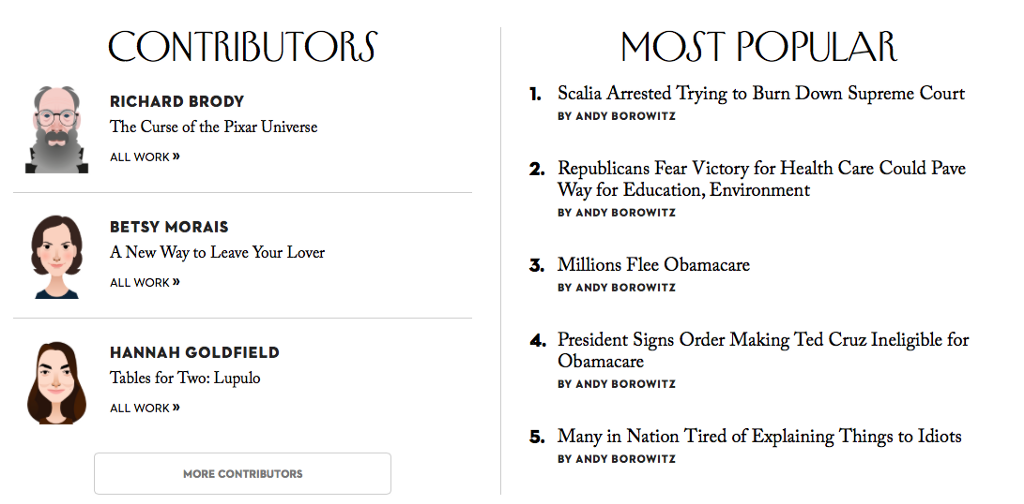
I’ve been waiting for this day for more than two years: the day that Andy Borowitz, a human fake news algorithm that also happened to generate the acting career of Will Smith, conquers the New Yorker’s website by authoring all five of the site’s most popular stories. There have been a few close calls in the past, where Borowitz has managed to occupy four of the five slots, but never before, to my knowledge, has he managed a clean sweep.
Two days ago, the New Yorker published a some-twenty-thousand-plus-word exclusive by Lawrence Wright about the efforts made by families to have their children returned from captivity in Syria. It is, as of publishing, no longer on the front page.
(via Dan Phiffer)
An Interview with Arabelle Sicardi
by Safy-Hallan Farah

Geniuses is a series in which we interview geniuses from all walks of life. For the third installment of Geniuses, we’re talking to beauty writer and editor @ArabelleSicardi.
Do you think you’re a genius?
No, I just think I’m clever. I don’t know the connotations of genius, or who I would consider one and if I could compare myself to them. I have a good sense of timing and I’m observant, I know I’m smart, but I also know when I’m not the smartest person in the room. And I try to not be the smartest person in the room. It’s boring being the smartest in the room. I’ve always liked hanging out with people who intimidate me so I can learn from them
Who intimidates you and why do they intimidate you?
Well, actually I haven’t met anyone who intimidates me lately because I’ve eaten the intimidation and made it into just admiration. Doreen St. Felix is a genius, Hannah, Durga are geniuses. They intimidate me and inspire me in equal measure. Being in a room with the women I love makes me feel very electric and makes my brain feel more connected. They make me feel more clever.
How did you turn intimidation into admiration?
Well I learned a long time ago that I’m not actually in a competition with people who aren’t men. Like, it’s pointless to me. When my friends started getting more successful I first felt initially really put out — why not me, you know — but someone I love reminded me women aren’t the enemy. So much about intimidation stems from fear of your power being taken from you, you know, being questioned. I don’t make space for that anymore. It’s a waste of time and energy and love. Actually there’s what, that Lil Kim quote? When you see a bad bitch don’t throw shade get her a Chanel bag? Something like that. We work better together. We have so much to learn from each other and give to each other if we let that happen.
What kind of men do you compete with?
I don’t think men occupy significant space in beauty writing or whatever so I don’t really compete with them on that level. I suppose I am currently competing with white male artists who colonize my work for their own capital, but I have also stopped making visual art at the moment to focus on writing, so it’s kind of a wonky battle. I am a very competitive person but mostly I’m in competition with myself. I get caught up in my own ego and in my own expectations and dreams for what I want to do a lot more than I do against others. My editors and friends always have to remind me it’s okay to fail and not change the world the way I want to in a piece. I always have to relearn. But I don’t look at so and so’s writing and be like, “I MUST BE BETTER THAN THEM.” Though sometimes I do get frustrated that I didn’t come up with it first. Which is I suppose the highest compliment. In the long run I’m always in competition with men who take up space that I want or that my friends want or need. Or men that have the money and intellectual capital that gets them stories or bylines that I’ve never been offered. But I also think those spaces will open up to me if I get aggressive and take them? I’m going to take them eventually. But to be fair, I read like, two male writers. It’s not even a protest thing, I just have only ever really enjoyed women writers.
Where do you want to be in a year or two from now?
Finishing up edits on a book, doing more travel-required writing on beauty. Writing less, but longer, and working on things outside of writing, too — I want to go to perfume school, I want to learn everything about the chemistry and production of beauty and also how it is marketed. I want to know every mundane aspect of beauty from the idea of a color of a lipstick to an auntie picking up the color in a wholesale store for a dollar once it’s been taken off the shelves at a big box retailer and sold for a loss. I’m less interested in trend pieces and more interested in pursuing stories that are ambitious and time consuming and terrifying in ways beauty journalism has rarely ever been before. I only want to do those stories for now and for the near future. That’s it — easier said than done, of course, but also pretty simple.
Mostly I wanna write a book though. Like please fight me if I haven’t written a book, Safy.
What do you think about the fact that beauty isn’t seen as an intellectual endeavor the way it SO is?
I think it’s beginning to be seen as an intellectual endeavor now, though — like, right now.
The past few months, very slowly people are beginning to understand more thoroughly that the concept of beauty is at the nexus of body politics and everything else it the world. it’s funny because when you research beauty theory, you only get white art theory about statues and whatever, in academia — in formal intellectual spaces, beauty is seen very narrowly and it misses the entire very literal conversation about labor and beauty and identity. the whole concept of “beauty theory” is so hard to find?
People talk about pop culture theory in terms of celebrity and the labor of them being visible in such and such ways but less about you know, labor and lipstick, how beauty products have always been a tool for imperialist propaganda, how the fact you can’t buy specific products in drugstores isn’t a coincidence or anything but a decision based on race, money, class, and power our conversations about beauty products often touch upon accessibility because our conversations are often complaints about these things — but few people inside the industry have ever spoken truth to power. because why would they when things have been going so well the way they have, for ages, for ever, really. The economics of beauty are terrible and terrifying and exploitative the same way fashion often/always is. but it’s not something to be spoken about because actually beauty companies are the ones that make a lot of publications possible. there is too much/a lot of risk exploring the connections between the beauty and fashion industries and well, every other industry in the world. particularly media. Beauty is obviously intellectual because it’s a matter of opinion and that opinion is and always has been shaped by the culture it is produced by and now people are finally catching on to the fact beauty and bodies don’t exist without context, history, or harm.
Do you see yourself going to graduate school?
Hell nah. College itself was torture. I don’t think I’d want to go back. I’d like to go to perfume school or learn trade things — but not school.
How was college torture for you?
I just wanted to get started as a writer. And the journalism program I was in was pretty misogynistic, so many of the professors there made me feel like nothing was worth anything at all. I actually loved and cherish my gender studies classes of course but I pretty much considered college a very expensive library visit. I lived in the library. I loved the library! And I don’t regret going to college, I just also wish I could have graduated even sooner. It was much worse for so many others, of course. I did the really practical thing and went to state school so my debt isn’t nearly as bad as it could be. In the scheme of things it was the right choice, that doesn’t mean I enjoyed it though. Academia was really frustrating and obtuse about lived experiences. I felt really jaded. And people take things really seriously in such a dry way and focus their entire life on proving a dead old white dude wrong for something he said like 200 years ago. I do not find that kind of work rewarding, personally. And to get accolades in academic work you have to play the game of language to get people to listen to you. I have no time for that. I do love theory, and I’m always stalking academia, but I don’t trust or love it or want the approval of those in it. I think it should be playful. It’s a tool but not the answer.
Tell me about your book now!
It’s a secret! I have many books in my head I have to choose from. I decided after I found out about that Yale dude that I have to get started on one RIGHT NOW. AS IN TODAY. I’ll tell you about it soon, though.
Would you say you’re good at keeping secrets?
Mine? Terrible at it. Others? Crypt keeper.
Forget Scalia! Justice Roberts Is a Total Marriage Moron
“the Court invalidates the marriage laws of more than half the States and orders the transformation of a social institution that has formed the basis of human society for millennia, for the Kalahari Bushmen and the Han Chinese, the Carthaginians and the Aztecs.” — Justice Roberts, dissent, Obergefell v. Hodges
Everyone loves to read a grumpy Justice Scalia dissent. He’s the best! And he’s already a parody of himself, although he parodies well. But you can’t breeze past the other dissents! They contain the delicious bit above from our Chief Justice. What a fascinating assertion! It’s just one of the many lies they tell about marriage for the social order. Shall we do this in order?
1. “The Kalahari Bushmen”

So a people who were, you know, mostly only married to one person at a time. In marriages that were sometimes arranged before people were even born. Who also sensibly practice infanticide when the lives of the family were threatened by the birth of a new child.
2. “The Han Chinese”
Tell us more about the millennia-old marriage traditions of Han Chinese civilization, Mr. Chief Justice pic.twitter.com/XpnWrnH4eK
— Tom Scocca (@tomscocca) June 26, 2015
No but for real. You can’t even begin to understand these marriage customs, which we would find offensive and extra-legal in many of the specifics.
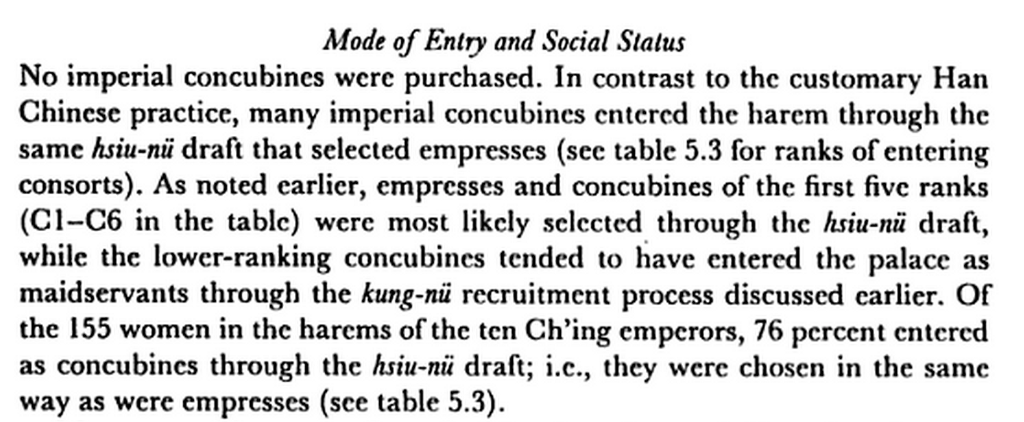
— Marriage and Inequality in Chinese Society.
3. The Carthiginians
There’s still a good bit of argument about whether they sacrificed babies in Carthage or not, or whether that was some sort of religious heresy, but it certainly has been handed down.

— Elements of Modern History. Oh right, also: “temple prostitutes.”
4. The Aztecs
Glad we saved the polyamorous, class-bound, common-law hand-fasting, trial-marriage-having Aztecs for last!
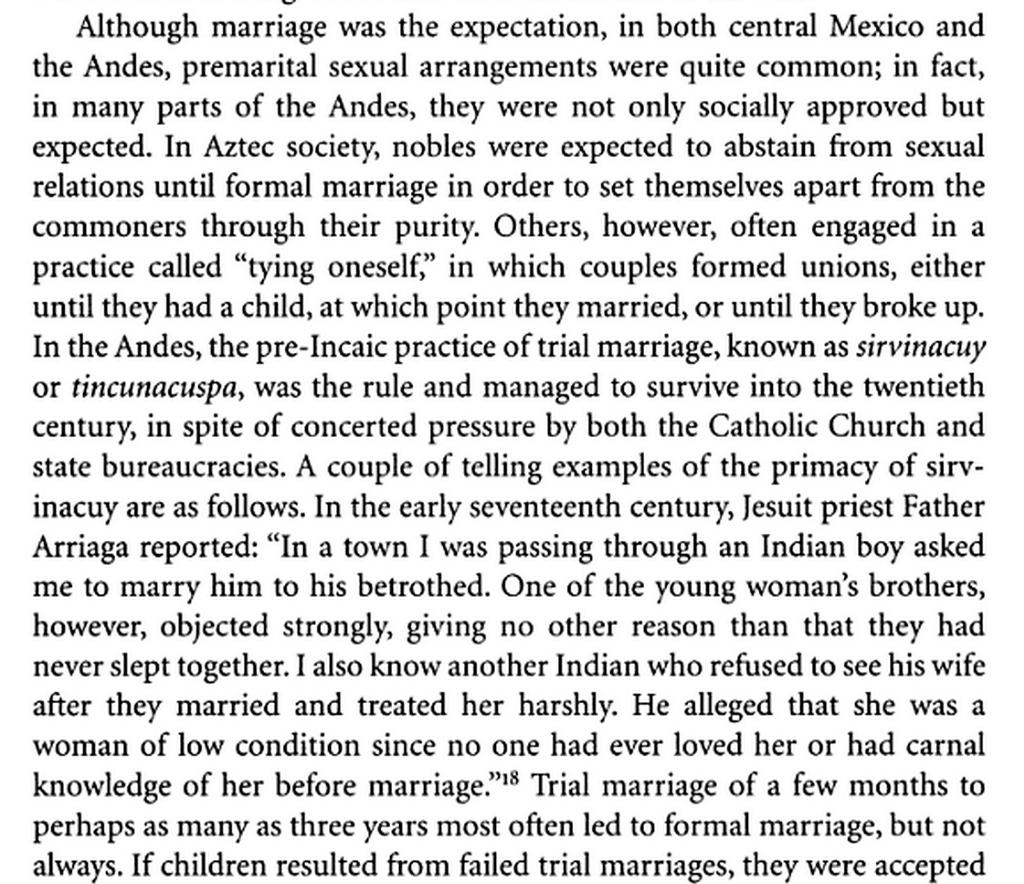
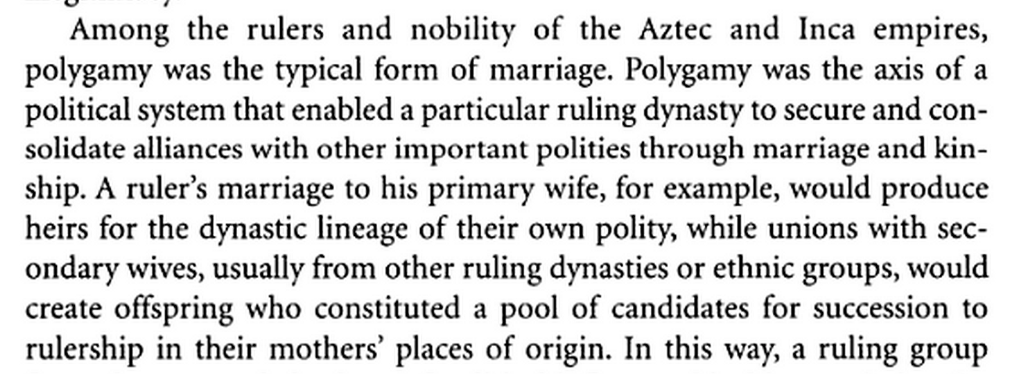
— Women in the Crucible of Conquest: The Gendered Genesis of Spanish American Society, 1500–1600
So very sorry we ruined all these cultures’ definition of marriage retroactively into prehistory!!!! Oh also some parts of ancient Rome, North Africa and China all had gay marriages???
Also this seems to be the same kind of dog whistle that the very odd Scalia diversity thing is mined from. Sorry that’s a mixed metaphor! But when the Court starts appealing to “the people” in this way, something smelly is afoot.
Obstacle Daunting
“Marc Lasry, a hedge fund manager, a major Democratic donor and a friend of the Clintons, let the campaign’s communications director, Jennifer Palmieri, stay in his family’s Manhattan home, a penthouse on Central Park West, for a handful of nights early on. The city, he said, ‘is expensive, particularly for young people. We have five children, so we are used to having a lot of people around, and we’re happy to put up folks from the campaign.’”
— Idealistic Clinton campaign staffers are faced with a daunting obstacle: the New York City real estate market. Jennifer Palmieri formerly served in the Obama administration as Assistant to the President and Director of Communications, so you can see just how high the daunt level must be, obstacle-wise.
New York City, June 24, 2015
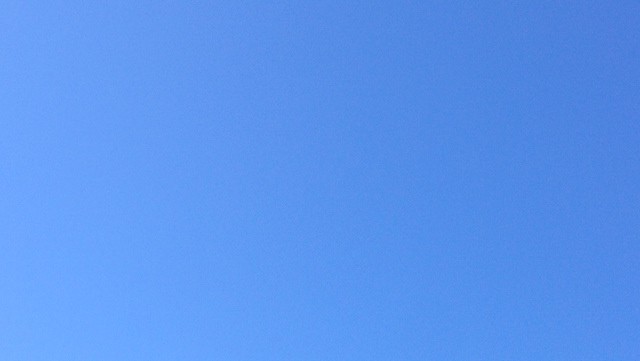
★★★★★ The sky was clean. A long-haired off-white mutt barked at a passing team of purebred pointers, just west of the park. Up the rise from the soccer camp were basketball campers, pushing balls straight up into the air. A smell of cut grass carried from somewhere. The blue was so deep that the hulk of the Time Warner Center was beginning to fade into it; the light pierced the hideous tinted-sunglasses windows of the Trump International Hotel and Tower to find furniture, curtains, a shirtless man. A superb cool breeze came down the shady side of Lafayette Street. Sun traced each little arch over the windows of the building above the bodega on Prince. Up on the roof, the aluminum case of the laptop threw off blinding glare like a tanning reflector, nor did the wireless signal reach there. But it was possible to stay on a chair in the shade on the fire escape indefinitely, blissfully.
Looking for the Real Song of the Summer
by Vijith Assar
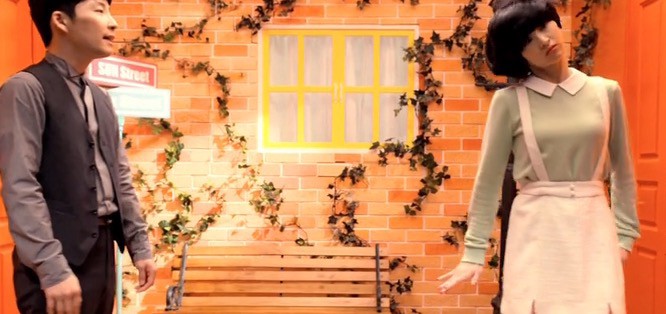
Last year’s putative “Song of the Summer” was a national embarrassment; as a result, American songs — and for safe measure, all songs in English — are no longer eligible. Each month, until summer has died, the Awl will present alternatives.
“Sun” by Gen Hoshino
#1 in Japan (Tokio Hot 100)
The Japanese songwriter’s new single is so relentlessly upbeat and optimistic that it almost reads as 2015’s response to Pharrell’s “Happy,” but it’s also somehow simultaneously weirder than anything currently happening in mainstream American pop. There are the unexpected production flourishes derived from disco, of course — shades of Michael Jackson’s “Rock With You,” or perhaps at least the lightweight adaptation of it he might have performed during a guest appearance on Sesame Street thirty years or so ago. But after a couple cycles, even the most dramatic horn stabs start to feel insignificant again, because the most readily identifiable “hook” is absent any lyrics, nothing more than a disorienting string of key changes sent around for absolutely no apparent reason other than to demonstrate its own serpentine logic before eating its own tail and arriving back at the starting line.
“Bobo” by Olamide
#1 in Nigeria (iTunes)
Rap verses in Yoruba aren’t even the most interesting thing about this — how strange to hear such heavy handed Auto-Tune quantizing of the vocal melody while the rhythm teeters to and fro! There’s a lot going on here — not in the sense that there’s a lot to unpack while discussing it, rather just literally a shit ton of sounds all overlaid atop one another simultaneously, instead of themes and flourishes entering and leaving in blocks of four bars at structurally meaningful points. It’s like you’re hearing the inside of a music box which is about to break, every gear and spring slipping out of place and detuning the notes in unexpected ways. Hence also the Auto-Tune, perhaps.
“Est-ce Que Tu M’aimes” by Maitre Gims
#4 in France (IFOP)
The attempts at moody grandeur start to fall flat once you realize he’s just going to keep loping through the pizzicato string plinks, but the vocal treatment here is a dead ringer for the fascinating screwball Timbaland yelps on “Morning After Dark,” and likely also a close analogue to whatever looming monster Flo Rida hit will inevitably soundtrack the sweatiest parts of August.
“Emlékszem, Sopronban (A Volt Fesztivál Himnusza)” by Wellhello and Halott Pénz
#1 in Hungary (Offizielle Deutsche)
That bouncy lil funk synth gets buried in verbed-out drum machine samples which must have seemed so unbelievably stupid on paper, and even all the way through the first turnaround, but then in a split second it quickly powers through the cheese and actually becomes one of the better recent juxtapositions of 1980s pop production nostalgia against more contemporary lyrical phrasing (see also: Taylor Swift’s “Style.”) The big drops sit just this side of E.D.M. caricature but are still obviously crafted explicitly for club sound systems, and should certainly be enough to help you get past the guy’s Macklemore haircut. Use this as your anthem for irresponsible behavior until further notice.
See you in July.
Urine, Urine Everywhere
If it’s summer it’s time for a reminder that the pool in which you swim is a chlorinated melange of urine and doody, and also sweat. But mostly urine. So much urine. It is almost as if the number one reason people jump into a pool is to pee in it. It’s a funny old world, and its pools are filled with urine.
Where Seinfeld Slept
by Brendan O’Connor
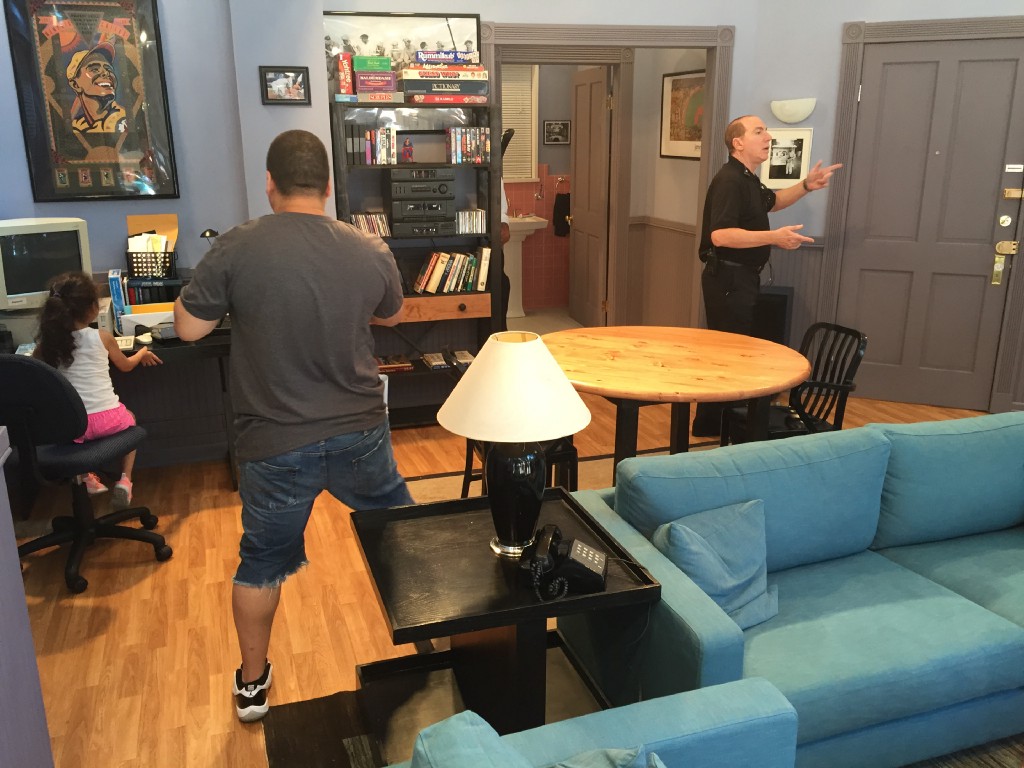
On Wednesday, Hulu made all hundred and eighty episodes of Seinfeld available to watch online, legally, for the first time. In celebration of Seinfeld’s new digital life, Hulu also opened a sort of pop-up Seinfeld museum that includes an immaculate reproduction of Jerry Seinfeld’s apartment in the television show; it appears that the only mistake that anyone has found so far is the use of a PC instead of a Mac computer.
Hulu, which is co-owned by Comcast, 21st Century Fox, and The Walt Disney Company, reportedly paid more than a hundred and fifty million dollars for the rights to stream Seinfeld. “We think it’s a one-of-a-kind property,” CEO Mike Hopkins told CNNMoney. “There aren’t too many shows that have a puffy shirt in the Smithsonian, for example. We believe that we’re going to be able to introduce ‘Seinfeld’ to a whole new young audience that’s here at Hulu,” he said. “We also think that Seinfeld will help us attract a new audience to Hulu.”
In the show Seinfeld, the character “Jerry Seinfeld” lives at 129 West 81st Street in apartment 5A, on the Upper West Side. (The person Jerry Seinfeld also lived there, for a time.) Exterior shots of this apartment were filmed at 757 New Hampshire Avenue, in Los Angeles; interior shots were mostly shot on set in California. According to Streeteasy, the real-life building was last sold in 1995 for close to a million dollars; in recent years, the building’s studio apartments have rented for just under two thousand dollars per month. The building appears on the NYC Rent Guidelines Board’s list of rent stabilized apartments in Manhattan, which would explain why the rent, in such a desirable area, is so low. It would also explain why Jerry never moves. We never learn what Jerry’s rent is, but, at one point, his upstairs neighbor dies, and her apartment comes on the market for four hundred dollars per month.
In 1998, shortly after Seinfeld went off the air, Seinfeld reportedly purchased a duplex in The Beresford, also on the Upper West Side, for 4.35 million dollars, into which he did not move until after he married Jessica Sklar in 2000. (He was definitely living there by 2001, when he MC’d the building’s holiday party.) Seinfeld was reported to have been looking at a townhouse on the Upper East Side in 2011, but he remained at The Beresford as of 2013.
A little after 10 A.M. on Wednesday, the line to get into Hulu’s Seinfeld apartment installation at Milk Studios in the Meatpacking District was already more than an hour long. Milk Studios is at 451 West 14th Street, adjacent to the High Line. The three-hundred-and-twenty-five-thousand-square-foot, eight-story office building was purchased in 2013 by Jamestown Properties for more than two hundred and eighty-four million dollars. (Jamestown also owns Chelsea Market; a bridge connects the two buildings.) Last October, the Commercial Observer reported that the building’s eighty-four-hundred-square-foot storefront space, which could be divided by up to three long-term tenants, was being marketed at three hundred dollars per square foot. In the meantime, pop-up tenants like Hulu are “breaking in the space,” Jamestown president Michael Phillips said.
In addition to the recreation of Jerry’s apartment, the Seinfeld exhibit contained several installations of memorable props and paraphernalia from the show: the table and seats from the interior diner set, in which visitors were not permitted to sit, and over which was hung a shot of Jerry and George Costanza sitting at the table, in the seats, on the set; the velvet couch on which George posed for his “Timeless Art of Seduction” photos, upon which visitors could pose as well; and Larry Thomas, the actor who played the “Soup Nazi,” was available, in costume, for photos. People in white T-shirts, upon which were printed the approximation of a puffy shirt, handed out posters and Junior Mints.
Once inside the exhibition, there was another, shorter line to get into Jerry’s apartment. Visitors could burst through the door in the manner of Cosmo Kramer, who, in the show lives across the hall from Jerry, in Apartment 5B, and has a proclivity for dramatic entrances. Several people did this. Cosmo Kramer is based on Kenny Kramer, a neighbor of Seinfeld co-creator Larry David’s at Manhattan Plaza, a federally subsidized housing complex at 43rd Street and 10th Avenue. Created in 1977, seventy percent of residents at the forty-six-floor Manhattan Plaza are in the performing arts, fifteen percent are locals, and fifteen are seniors. The building is a hundred percent affordable; residents pay thirty percent of their income in rent. In 2013, Related Companies, the developer responsible for construction of Hudson Yards, secured funding for a hundred-and-twenty-six-unit development at 529 West 29th Street that would mirror — in terms of affordability and resident composition — Manhattan Plaza, where the wait list for an apartment is years long.
In 1996, Kenny Kramer decided to embark, as he was wont to do, upon a new business venture: Kramer’s Reality Tour, a guided tour of Seinfeld-related locations around New York City. “I’ve promised myself that I’ll work hard for two years so I can then officially retire,” Kramer told the New York Times. After that, he said, “My goal… is to have an actor playing my part. That way we’ll have art imitating life imitating art imitating life. And I can sit in the Jacuzzi back home.” Kramer’s Reality Tour is now in its nineteenth year.
One of the walls of Hulu’s Seinfeld apartment is floor-to-ceiling glass. Visitors still waiting on the sidewalk outside peered in at those of us making our way through the space: a recreation, refracted through screens and memory, rendered in immaculate detail, of a fabrication; a three-dimensional advertisement designed to trigger, through obsessive nostalgia, compulsive consumption; advertising imitating art imitating life imitating art imitating life. We were not encouraged to linger.
Have you noticed a real estate listing that you would like to have investigated? Send cool tips, fun listings, and hot gossip to brendan@theawl.com.
Tea People Just As Annoying As Coffee People
“Look: I know this all sounds nuts, and I’ve seen the expression you’ve got on your face. Experienced tea people are reluctant to believe something so simple will work. But I’ve been using it for years, and, for the teas that I make both ways, I have never had a tea that gave flavor hot that was not attainable cold. (Yes, there may be teas I don’t like cold that the method wouldn’t work for.) Pick a couple of your best teas and try the method.”
— I did not know until this week what kind of strong opinions people had about iced tea and the methods of its manufacture, but I guess I should not be surprised, because the thing about people is they’re the worst, and also they are not particularly quiet about it.
A Poem by Dani Couture
by Mark Bibbins, Editor
I Come Around With Appetite to Parties
An evening carousel of who died, which
winds ribboned down, and the difference
between something bruised or broken.
The treatment is the same. No, it’s not
enough to say you were there, felt it snap,
or shuttered a photo. Instead, run a man’s cold
finger down your breastbone and ask, See?
Feel that. Right there? I think it’s broken.
Pain, like living, requires corroboration.
So he palms your left breast and pushes
until something gives. A sound. His
opinion. A hole dug and the declaration
of empty space as something new.
An inverse peak. He confirms what’s already
inside you. Rib dispossessed of its hold,
the punchline out of sync. Meanwhile,
a mine shaft in South America collapses.
A deflation, though you are filling with things
that are not yours. What’s broken rises
like loaves. You’ve been researching
these injuries, this news, for hours.
Tell me, I’m right. That there’s a difference
between a spout and funnel. A fracture
and separation. A plane that was cleared to fly
or wasn’t. If the buk was stolen or given.
Birds kettle and people are kettled. The kettle
I forgot sings a high whistle. The dead are still
dead except we keep finding new things
to say about them. Every day is a rehearsal.
Set the action. Reach your end point. Reset.
Remember to look up and to the left.
You’re running for your life. The effects will
be added later, but we need your fear now.
They gave me a blue and white dress, sewed me
in, but said I could keep my own black shoes.
Said, if need be, we’ll cut you out at the end.
(Note: Title from a line in Eileen Myles’s poem “keats & i”)
Dani Couture is the author of three collections of poetry, most recently, YAW (Mansfield Press, 2014), and the novel Algoma (Invisible Publishing, 2011). Sweet (Pedlar Press, 2010) was nominated for the Trillium Book Award for Poetry and won the ReLit Award for poetry.
You will find more poems here. You may contact the editor at poems@theawl.com.
